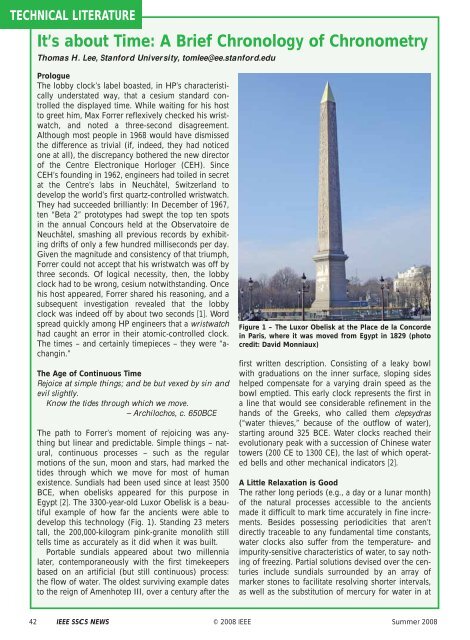Eric Vittoz - IEEE
Eric Vittoz - IEEE
Eric Vittoz - IEEE
You also want an ePaper? Increase the reach of your titles
YUMPU automatically turns print PDFs into web optimized ePapers that Google loves.
TECHNICAL LITERATURE<br />
It’s about Time: A Brief Chronology of Chronometry<br />
Thomas H. Lee, Stanford University, tomlee@ee.stanford.edu<br />
Prologue<br />
The lobby clock’s label boasted, in HP’s characteristically<br />
understated way, that a cesium standard controlled<br />
the displayed time. While waiting for his host<br />
to greet him, Max Forrer reflexively checked his wristwatch,<br />
and noted a three-second disagreement.<br />
Although most people in 1968 would have dismissed<br />
the difference as trivial (if, indeed, they had noticed<br />
one at all), the discrepancy bothered the new director<br />
of the Centre Electronique Horloger (CEH). Since<br />
CEH’s founding in 1962, engineers had toiled in secret<br />
at the Centre’s labs in Neuchâtel, Switzerland to<br />
develop the world’s first quartz-controlled wristwatch.<br />
They had succeeded brilliantly: In December of 1967,<br />
ten “Beta 2” prototypes had swept the top ten spots<br />
in the annual Concours held at the Observatoire de<br />
Neuchâtel, smashing all previous records by exhibiting<br />
drifts of only a few hundred milliseconds per day.<br />
Given the magnitude and consistency of that triumph,<br />
Forrer could not accept that his wristwatch was off by<br />
three seconds. Of logical necessity, then, the lobby<br />
clock had to be wrong, cesium notwithstanding. Once<br />
his host appeared, Forrer shared his reasoning, and a<br />
subsequent investigation revealed that the lobby<br />
clock was indeed off by about two seconds [1]. Word<br />
spread quickly among HP engineers that a wristwatch<br />
had caught an error in their atomic-controlled clock.<br />
The times – and certainly timepieces – they were “achangin.”<br />
The Age of Continuous Time<br />
Rejoice at simple things; and be but vexed by sin and<br />
evil slightly.<br />
Know the tides through which we move.<br />
– Archilochos, c. 650BCE<br />
The path to Forrer’s moment of rejoicing was anything<br />
but linear and predictable. Simple things – natural,<br />
continuous processes – such as the regular<br />
motions of the sun, moon and stars, had marked the<br />
tides through which we move for most of human<br />
existence. Sundials had been used since at least 3500<br />
BCE, when obelisks appeared for this purpose in<br />
Egypt [2]. The 3300-year-old Luxor Obelisk is a beautiful<br />
example of how far the ancients were able to<br />
develop this technology (Fig. 1). Standing 23 meters<br />
tall, the 200,000-kilogram pink-granite monolith still<br />
tells time as accurately as it did when it was built.<br />
Portable sundials appeared about two millennia<br />
later, contemporaneously with the first timekeepers<br />
based on an artificial (but still continuous) process:<br />
the flow of water. The oldest surviving example dates<br />
to the reign of Amenhotep III, over a century after the<br />
Figure 1 – The Luxor Obelisk at the Place de la Concorde<br />
in Paris, where it was moved from Egypt in 1829 (photo<br />
credit: David Monniaux)<br />
first written description. Consisting of a leaky bowl<br />
with graduations on the inner surface, sloping sides<br />
helped compensate for a varying drain speed as the<br />
bowl emptied. This early clock represents the first in<br />
a line that would see considerable refinement in the<br />
hands of the Greeks, who called them clepsydras<br />
(“water thieves,” because of the outflow of water),<br />
starting around 325 BCE. Water clocks reached their<br />
evolutionary peak with a succession of Chinese water<br />
towers (200 CE to 1300 CE), the last of which operated<br />
bells and other mechanical indicators [2].<br />
A Little Relaxation is Good<br />
The rather long periods (e.g., a day or a lunar month)<br />
of the natural processes accessible to the ancients<br />
made it difficult to mark time accurately in fine increments.<br />
Besides possessing periodicities that aren’t<br />
directly traceable to any fundamental time constants,<br />
water clocks also suffer from the temperature- and<br />
impurity-sensitive characteristics of water, to say nothing<br />
of freezing. Partial solutions devised over the centuries<br />
include sundials surrounded by an array of<br />
marker stones to facilitate resolving shorter intervals,<br />
as well as the substitution of mercury for water in at<br />
42 <strong>IEEE</strong> SSCS NEWS © 2008 <strong>IEEE</strong> Summer 2008




